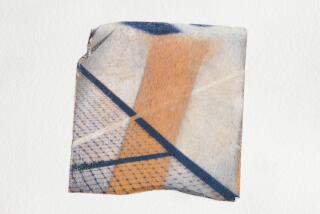Connors Scoffs at Burnout
- Share via
James Scott Connors, master mechanic, peered across the net to check the problem at hand. It was like a plumber probing a leak.
Across from him was Johan Kriek. Now, as leaks go, Kriek is not major. The carpeting is safe. Connors has always been able to dam up the Johan Krieks, usually in the quarterfinals or earlier in the bigger tournaments.
The problem here is, our master mechanic Connors is 42. In some sports, that’s past prime time. In tennis, it’s slippers and hot water bottle time.
Unless you’re Jimmy Connors. Jimmy’s contract with life had no provision for getting old. Jimmy doesn’t intend to get old. He might get winded earlier in the match, but there are ways of getting around that.
Kriek is eight years younger than Connors. A minor hurdle. Kriek is also 10 pounds overweight. Jimmy has never been overweight in his life.
Jimmy sizes up the situation. An adjustment here, a poke there, a wrench at the right time and Kriek will be all plugged up.
Jimmy wound up, contorted his body like a guy aiming a slingshot at the moon--and hit maybe his 2 millionth serve. Or, maybe his 20 millionth. Who’s counting? Jimmy has been serving tennis balls since he was old enough to stand. Other babies got rattles. Jimmy got rackets. Jimmy won his first tennis set before he was able to count that high.
It has been a strange career. Jimmy was born in East St. Louis, and for those who have never been there, it is to modern society what Dodge City or Tombstone was to the Old West. Jimmy had a better chance of being a gangster than a tennis player. “That’s why my mother got a racket in my hands,” he says now. She was afraid that if she didn’t, a machine gun would be there.
Jimmy’s career was probably 50% talent and 50% determination. So he made a habit of beating guys whose ratio was 90-10.
Jimmy didn’t have a 130-m.p.h. serve. He wasn’t especially fast. But he always hit the ball hard and usually someplace you just left.
Besides, you couldn’t get the ball past him. Sometimes, when you thought you had, and the ball appeared safely behind him, Connors would somehow get a racket on it behind his back. It was almost as if he had two rackets. And it didn’t matter whether the ball came on a big serve or a changeup lob, Jimmy hit it back to your feet. It was very discouraging. Jimmy was like Joe DiMaggio. When the ball came down, he was there. You couldn’t smuggle a volley past him.
And, of course, Connors was mean. Tennis is a courtly game--but not the way Jimmy plays it. Jimmy challenged the whole environment. Linesmen, referees in the chair, even the crowd, were targeted by Jimmy. He was the original brat on the tennis circuit. Jimmy never added the grace note. He just beat you. You got a problem with that? Go see the chaplain.
One of the guys Jimmy didn’t pamper was Jimmy. Tennis players are getting as fragile as violets. If they don’t have a physical infirmity, they invent a mental one. The trouble is, you can’t perform arthroscopic surgery on the brain. Ennui is incurable.
Connors never got “burnout.” He was always afraid someone would take him off the court, never mind his saving them the trouble. Jimmy plans to take a bagful of rackets to the pearly gates and start looking for a linesman to criticize.
Jimmy won two Wimbledon titles and was runner-up four times--to Bjorn Borg twice, to Arthur Ashe and John McEnroe. He won five U.S. Open titles and was runner-up twice. He won 116 singles titles.
Connors never let the game get away from him. No long withdrawals, no trips to places where they never heard of a let, no weeks in contemplation. Jimmy was usually on a court or on a plane on the way to one.
Jimmy played from such an early age that he had to grip the racket with two hands on every shot. The racket was almost as heavy as he was. So, when he got to UCLA, he still used both hands on the backhand. The purists were consternated. Two-handed backhands were for girls, or juniors, not Wimbledon finalists, they said. Jimmy did what he usually did: He proved them wrong. No one tells Jimmy Connors how to grip a tennis racket. It’s like telling Rockefeller how to count.
He had the peripheral vision of a goldfish. “I can see behind me,” he says, smiling. His eyes, like Ted Williams’, are better than 20/20. They dart sideways, upward, downward--like a fox zeroing in on a chicken. They have almost no whites showing. They are the eyes of a man not to be messed with.
So he played last week at Sherwood Country Club in the Digital PC Champions tournament, a 10-stop senior tour invented by Connors himself.
He sized up Kriek. He checked the lines crew to see whom he could profitably intimidate. He checked the flags for wind, the court for bounce, then he turned his attention to Kriek. He won in straight sets, not overwhelmingly, merely convincingly, 7-5, 7-5. He let Kriek beat himself, then he moved in to mop up. The next day, he won the tournament, defeating Jose-Luis Clerc, 7-5, 5-7, 6-2.
It was vintage Connors. Connors on court is Casey at the bat, Horowitz at the piano, Olivier at the Old Vic. Arnold Palmer was born to play golf; Connors was born to play tennis.
What’s his secret? “Tenacity,” Connors says. “The edge I had was minute, but minute is enough if you use it right. I was never greedy and I never had fear. I just got the shot back if it was a great shot, I didn’t try to fashion a winner out of it--and I had no fear. I played the same when I was behind, 4-6, 4-6, as I did when I was ahead, 6-4, 6-4. I never figured a game was over ‘til I heard those terrible words, ‘Game, set and match!’ Right up ‘til then, I figured it was up for grabs.”
He thinks burnout is for fire departments to worry about, not athletes. As far as aging is concerned, Jimmy treats it like any other opponent with a faulty backhand or weak second serve. He might not even have to argue the line calls.
More to Read
Go beyond the scoreboard
Get the latest on L.A.'s teams in the daily Sports Report newsletter.
You may occasionally receive promotional content from the Los Angeles Times.










